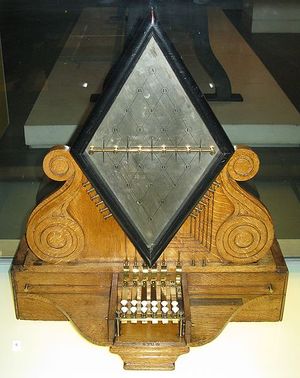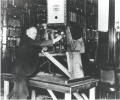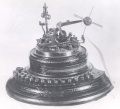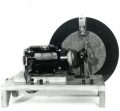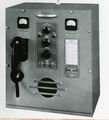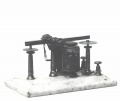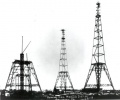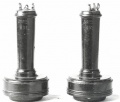Category:Communications
Communications refers to the use of signals to transfer voice, data, image, and/or video information between locations. Its main aspects are communications science, engineering, and technology. Communications technology is among the first practical uses of electrical engineering; the telegraph was first conceived in the 1700s and realized in 1837 by Charles Wheatstone and William Cooke. Later inventions which would completely change how society exchanges information include such devices as the telephone, radio and television.
Spanning the interests of many IEEE technical societies, communications has always been a large part of the Institute’s activities. The IEEE Communications Society promotes the advancement of science, technology and applications in communications and related disciplines, whereas the IEEE Broadcast Technology Society deals specifically with the broadcast element of communications. In addition, IEEE has many publications relating to communications, including IEEE Communications Magazine, IEEE Network, IEEE Wireless Communications Magazine, IEEE Transactions on Communications, IEEE Communications Letters, IEEE Journal on Selected Areas in Communications, IEEE Transactions on Network and Service Management and IEEE Transactions on Wireless Communications.
Subcategories
- Broadcasting - The transmission of audio or video to an audience.
- Communication equipment - This refers to both the hardware and software used for different types of communication.
- Communication methods - Methods used for different types of communication (broadband, mobile, multimedia, etc.) and for different purposes (biomedical, military).
- Communication networks - A network of communication circuits managed as a single unit.
- Communication switching - Used to enable sharing of physical lines of communication.
- Communication systems - Elements of communications systems, such as protocols, quality of service and routing are covered.
- Couplers – Coupling is the transfer of energy from one medium to another.
- Electronic switching systems - An automatic switching system in which the control functions are performed principally by electronic devices.
- High-speed electronics - Includes integrated circuits, networks, and Ultrafast electronics.
- Image communication - Includes facsimile, picture archiving and communication systems.
- Message systems - Includes postal services and voice mail.
- Multiplexing - The combining of two or more signals into a single wave from which the signals can be individually recovered. Examples include time division multiplexing and frequency division multiplexing.
- Radio communication - Includes types (indoor, land mobile, etc.) and aspects (frequency, spectrum management, etc.).
- TV - Cable, digital, and mobile television are covered.
- Telegraphy - A system of telecommunication for the transmission of graphic symbols, usually letter of numerals, by the use of a signal code. Types include electrical, radio, and wireless.
- Telephony - The use of devices for voice communication, for example, cellular and digital telephone systems.
- UHF & VHF technology - The technologies used for "ultra-high" and "very-high" radio frequencies.
- Ultra wideband technology – Technologies using extremely narrow pulses and very wide frequencies.
Subcategories
This category has the following 25 subcategories, out of 25 total.
C
Pages in category "Communications"
The following 941 pages are in this category, out of 941 total.
A
- Archives:A Modern Concept of Modulation
- Education:A Newspaper in time - an Abolitionist Account
- First-Hand:A Passion for Radio
- Archives:A Review of Tropospheric Scatter Communications
- M. Robert Aaron
- George Abraham
- Yuri Abramovich
- Archives:Active Filters
- Oral-History:Norbert Adler
- Robert Adler
- Oral-History:William Ross Aiken
- Haruo Akimaru
- Naofal Al-Dhahir
- Siavash Alamouti
- Andrew Alford
- First-Hand:Ally of Peace, Global Telecommunications in the Information Age
- First-Hand:AM Noise Reduction System
- Amateur Radio
- Milestones:American Standard Code for Information Interchange ASCII, 1963
- Milestones:Ampex Videotape Recorder, 1956
- John S. Anderson
- Oral-History:Fred Andrews
- Frederick T. Andrews
- Jeffrey G. Andrews
- IEEE Antennas and Propagation Society History
- George Antheil
- Toshiharu Aoki
- First-Hand:Applying Advanced Technology to Cryptologic Systems: Some Special Management Challenges
- Edwin H. Armstrong
- Francis Lawrence Armstrong
- Kevin Ashton
- Oral-History:William Aspray
- First-Hand:AT&T Mod 1-A Deaf Terminal
- Stephen Attwood
- Oral-History:Werner F. Auerbacher
- Charles Francis Avila
- Archives:Jack Avins, The Essence of Engineering
B
- Victor Bahl
- George W. Bailey
- Oral-History:Kenneth T. Bainbridge
- John Logie Baird
- Archives:Baird Televisor Documents
- Walter Baker
- Hari Balakrishnan
- John William Bandler
- Oral-History:Jens Bang
- Oral-History:Paul Baran
- Ivo Barbi
- Thomas Pinkney Barnwell, III
- Oral-History:C.E. Barrette
- Oral-History:Bruce Barrow
- Oral-History:Lionel Barthold
- Charles Batchelor
- Ralph Batcher
- Archives:BBN computing history: A Culture of Innovation
- Oral-History:Arnold Beck
- Alda V. Bedford
- Leslie H. Bedford
- David Belanger
- Vitold Belevitch
- Alexander Graham Bell
- Archives:Papers of Alexander Graham Bell
- Archives:Bell Labs & The Origins of the Multimedia Artist
- Oral-History:Maurice Bellanger
- Benjamin M. Rosen
- William R. Bennett
- Oral-History:Leo Beranek (2005)
- Lloyd V. Berkner
- Emile Berliner
- Edward Bernds
- Claude Berrou
- Alexander E. Bettis
- Harold H. Beverage
- Oral-History:Harold H. Beverage
- Oral-History:Harold H. Beverage and H. O. Peterson
- Vijay K. Bhargava
- Carroll O. Bickelhaupt
- Dieter Bimberg
- Bing Crosby and Magnetic Recording
- First-Hand:Bing Crosby and the Recording Revolution
- Frank Bingley
- Michael J. Birck
- Birth of Radio Location in the United States Navy - Chapter 4 of Radar and the Fighter Directors
- Oral-History:Harold S. Black
- Otto B. Blackwell
- Oral-History:Ron Blicq
- Ron Blicq
- Hendrik W. Bode
- Henry Booker
- James V. Boone
- Calvin Bopp
- Oral-History:Berthold Bosch
- Jagadish Chandra Bose
- Charles Bourseul
- Edward L. Bowles
- Ralph Bown
- Ronald N. Bracewell
- Karl Braun
- Wayne Bretl
- Oral-History:Yvonne Brill
- Robert Briskman
- Oral-History:Robert Briskman
- IEEE Broadcast Technology Society History
- George Brown
- Walter Bruch
- Oral-History:Per Bruel
- Charles F. Brush
- Don Buchla
- Oliver Buckley
- Christopher Buff
- Kenneth Bullington
- Oral-History:Richard Burden
- Mark L. Burgener
- Oral-History:Arthur Burks
- Robert Page Burr
- Charles R. Burrows
- Henri Busignies
C
- First-Hand:C-Band Story
- Archives:Cable TV - What's Happening
- Oral-History:James Thomas Cain
- Robert Calderbank
- George Campbell
- Oral-History:Norm Caplan
- Oral-History:Francesco Carassa
- Michel A. G. Carpentier
- John R. Carson
- E. Finley Carter
- Archives:Papers of John Joseph Carty
- Cell Phone Antenna Links
- The Foundations of Mobile and Cellular Telephony
- Archives:A Century of Electricals
- Oral-History:Vinton Cerf
- Chain Home
- First-Hand:Challenges IEEE Faced Supporting Ethical Behavior and Professionalism
- Edwin A. Chandross
- Sheldon Chang
- Claude Chappe
- Oral-History:Robert Chapuis
- Francis J. Chesterman
- Mung Chiang
- George Chrisikos
- Alan G. Chynoweth
- John M. Cioffi
- Richard Citta
- Oral-History:Jacques Clade
- Arthur C. Clarke
- Jon K. Clemens
- Danny Cohen
- Coherer
- Charles H. Coleman
- Columbia Record Company
- Communication Technologies and Liberation Movements
- Archives:Communication Trends and Problems
- Oral-History:IEEE Communications Society
- IEEE Communications Society History
- Archives:Communications - Tomorrow's Substitute for Transportation
- Archives:Communications and the Computer
- Communications Technology Paradoxes
- First-Hand:Computer Security
- William Fothergill Cooke
- Cooke and Wheatstone's Electric Telegraph
- Martin Cooper
- Miles A. Copeland
- Daniel J. Costello
- Robert F. Cotellessa
- Donald C. Cox
- Oral-History:Donald Cox
- Murray G. Crosby
- Oral-History:C. Chapin Cutler
- George M. Cutter
D
- Oral-History:Daniel Toland
- DATAR - First Digital Computer/Communications System for Anti-Submarine Warfare
- Archives:The Inventions of Thomas Davenport
- Edward E. David, Jr.
- Oral-History:Donald Davies & Derek Barber
- Robin E. Davies
- Mark Edward Davis
- Oral-History:Dawn Tilbury
- Frank de Jager
- J. Roberto de Marca
- Lee De Forest
- Oral-History:Edward de Laet
- E. Maurice Deloraine
- Oral-History:Charles Denton
- Gururaj Deshpande
- Milestones:Development of CDMA for Cellular Communications, 1989
- Alton C. Dickieson
- Suhas N. Diggavi
- First-Hand:Digital Television: The Digital Terrestrial Television Broadcasting (DTTB) Standard
- Distributed ledgers
- Dariush Divsalar
- Thomas W. Doeppner
- William H. Doherty
- Amos Dolbear
- R. B. Dome
- Oral-History:Herbert Doring
- Irwin Dorros
- Oral-History:Rudolf Drabek
- Archives:Dubilier Condenser Materials
- Gano Dunn
- Philippe Dupuis
- Oral-History:Sajjad Durrani
- Hendrik C. A. Van Duuren
E
- First-Hand:Early Recollections of Ham Radio
- Christopher M. Earnshaw
- Melville Eastham
- Thomas Edison at Menlo Park
- First-Hand:Education and Management in an IEEE Life Member's Career
- Electrical Recording
- Electromechanical Telephone-Switching
- First-Hand:Electronic Warfare, Radio Receivers and Countermeasures
- Lynn Ellis
- Oral-History:Joel Engel
- Joel S. Engel
- Enhancing a video of an event at a remote location using data acquired at the event (Patent)
- Enhancing video using a virtual surface (Patent)
- Epilog - What is the “Right Stuff” for a fighter director? - Chapter 14 of Radar and the Fighter Directors
- Oral-History:Lloyd Espenschied
- Lloyd Espenschied
- Oral-History:Thelma Estrin (1992)
- Etheric Force
- Oral-History:Hong Eu
- W. E. Evans, Jr.
- First-Hand:Event in Telecom Switching Development
- Oral-History:Bruce W. Everitt
- Evolution of Cell Phone Technology
- Oral-History:Walter Ewanus
F
- F. J. Bingley
- Moses G. Farmer
- Farnsworth's Image Dissector
- Fax Machines
- Gustave-Auguste Ferrié
- Reginald A. Fessenden
- Fessenden's Christmas Eve Broadcast
- Fessenden's underwater ice finder
- Fiber Optics
- Archives:Papers of Cyrus Field
- Fighter Direction Spreads from the Carriers - Chapter 9 of Radar and the Fighter Directors
- Mário A.T. Figueiredo
- First Broadcast from Another World
- Milestones:First Direct Broadcast Satellite Service, 1984
- Milestones:First Satellite Broadcasting to the Public
- Milestones:First Television Broadcast in Western Canada, 1953
- First-Hand:Philips Telephone Exchanges and Denmark 1980-1990
- Oral-History:Joseph Fischer
- Avery Fisher
- James L. Flanagan
- Oral-History:Steward Flaschen
- Clarence E. Fleager
- John Fleming
- Oral-History:Virgilio Floriani
- Norman F. Fyler
- David Flynn
- FM Radio
- The Making of Football's Yellow First-and-Ten Line
- Oral-History:G. David Forney
- G. David Forney, Jr.
- Oral-History:Ted Foster
- France Builds Visual Telegraph
- Adolf Ludwig Franke
- C. S. Franklin
- Alexander G. Fraser
- Archives:The Centre National d'Etude des Telecommunications and the Competitiveness of French Telephone Industry, 1945-1980
- Richard H. Frenkiel
- Harald T. Friis
- Education:From cuneiform to satellite - How did we get there?
- First-Hand:From Radio Engineering to War-Time Research
- First-Hand:From War-Time Radio to Peace-Time Television
- Oral-History:Hugo Fruehauf
- Oral-History:Den Fujita
- Leonard F. Fuller
- Oral-History:Leonard Fuller
G
- G. A. Morton
- Robert G. Gallager
- Robert W. Galvin
- Oral-History:Karl Ganzhorn
- Oral-History:Wanda Gass
- Carl Friedrich Gauss
- Oral-History:Paolo Gazzana-Priaroggia
- Oral-History:Leslie Geddes
- First-Hand:George Whitehead Apollo S-Band Communications
- Archives:Papers of Bancroft Gherardi
- Oral-History:Clinton Gilliland
- Oral-History:Joseph Giordmaine
- Frederic N. Gisborne
- Alain Glavieux
- Oral-History:Frank W. Godsey
- Bernard Gold
- Oral-History:Goldey, Hittinger and Tanenbaum
- Peter Goldmark
- Andrea Goldsmith
- Oral-History:Andrea Goldsmith
- Oral-History:Thomas Goldsmith
- Archives:Goldsmith articles
- Solomon Golomb
- Education:Good Vibrations - How Americans Fell in Love with the Telephone
- Oral-History:Eugene Gordon
- Naohiro Goto
- Elisha Gray
- Frank Gray
- Great Eastern
- Oral-History:Wilson Greatbatch
- Johannes A. Greefkes
- Archives:Papers of Norvin Green
- Oral-History:Paul Green
- Albert G. Greenberg
- Marshall Greenspan
- Larry J. Greenstein
- Oral-History:William Gretsch
- Hugh Griffiths
- Al Gross
- Oral-History:John Guarrera
- Oral-History:Klaus Gueldenpfennig
- Guide system and method of operation (Patent)
- Oral-History:Vince Gulden
H
- Oral-History:Abraham H. Haddad
- Joachim Hagenauer
- Archives:Papers of George Hamilton
- John Hammond
- Oral-History:Ki Sun Han
- First-Hand:Hand-Held Radios and Electronic Beepers
- Malcolm P. Hanson
- Oral-History:Keld Harder
- Oral-History:Ann Hardy
- Oral-History:Buddy Harris
- Archives:Papers of W.H. Harrison
- Ralph Hartley
- Martin Hasler
- Thomas Haug
- Oral-History:Paula Hawthorn
- Oral-History:Izuo Hayashi
- Oral-History:Floyd Hayhurst
- Oral-History:Marlene Hazle
- Robert W. Heath, Jr.
- Raymond A. Heising
- Martin Hellman
- Hello Girls
- Keith Henney
- Edward W. Herold
- Eric Herz
- Beatrice Alice Hicks
- Archives:High Gain to Noise Temperature Ratio Antennas for Space Communications
- Oral-History:David Hill
- Archives:History of Land, Mobile and Personal Communications
- History that weren't so: Myths and Misperceptions
- Tracking the Ice Hockey Puck - FoxTrax (Glow Puck)
- John Hogan
- Herman Hollerith
- John M. Hollywood
- Oral-History:Knud Holst
- Oral-History:Karl Honaman
- Oral-History:Don Hooper
- Stanford Hooper
- Erna Schneider Hoover
- Lawrence C. F. Horle
- Oral-History:Mel Hotz
- Richard R. Hough
- Oral-History:Ayanna Howard
- Henry Taylor Howard
- Linwood S. Howeth
- David E. Hughes
- Albert W. Hull
- Archives:Papers of B.D. Hull
- Oral-History:Roger Hull
- Ross A. Hull
- Gaylord K. Huth
- Lawrence A. Hyland
I
- IBMs Millipede Memory Chip
- Masaru Ibuka
- Archives:ICC 1976 Keynote Luncheon - Benjamin L. Hooks
- Iconoscope
- Archives:IEEE Aerospace and Electronic Systems Magazine Historical Articles
- Archives:IEEE History Center Book Publishing
- First-Hand:Changes In IEEE Are Needed To Create A "Self Directed Professional Society"
- The IET (Institution of Engineering and Technology)
- First-Hand:Innovations in Radio Communications: Post WWI
- Hiroshi Inose
- Interactive computer system for providing television schedule (Patent)
- Internet of Things
- First-Hand:Internet's Origin
- First-Hand:Inventing the Vidifont: the first electronics graphics machine used in television production
- Archives:Misc. IRE Correspondence
- Island Hopping - Chapter 12 of Radar and the Fighter Directors
- First-Hand:It Started with Ham Radio
- Oral-History:Fumitada Itakura
- Oral-History:Tatsuo Izawa
J
- A. Christian Jacobaeus
- Oral-History:Irwin Jacobs
- Irwin M. Jacobs
- Paul E. Jacobs
- Hamid Jafarkhani
- David Jaggar
- William C. Jakes, Jr.
- Technology in the James Bond Universe
- Jack L. Jatlow
- Oral-History:F. Suzanne Jenniches (2010)
- Oral-History:Jacob Jensen
- Wang Jianzhou
- Amos E. Joel, Jr.
- Oral-History:Amos Joel (1992)
- Oral-History:Amos Joel (1993)
- Archives:The Magic of Your Dial: Amos Joel and the Advent of Electronic Telephone Switching
- Oral-History:Rudy Joenk
- John B. Johnson
- Biing-Hwang Juang
- System for measuring a jump (Patent)
K
- Oral-History:Robert Kahn
- Robert Kahn
- Walter Kahn
- Oral-History:James Kaiser
- Takehiro Kakizaki
- Oral-History:In-Ku Kang
- Oral-History:Jin Ku Kang
- Oral-History:Ki Dong Kang
- Oral-History:Sung Mo (Steve) Kang
- Sam H. Kaplan
- John E. Karlin
- Oral-History:Katsutaro Kataoka
- Archives:KDKA Letter, 1921
- KDKA, First Commercial Radio Station
- William Keister
- Eugene O. Keizer
- Ray D. Kell
- Oral-History:Arthur C. Keller
- Arthur C. Keller
- Frank Kelly
- Archives:Papers of Lord Kelvin
- Archives:Papers of Arthur Edwin Kennelly
- Oral-History:Warren A. Kesselman
- Raymond W. Ketchledge
- Oral-History:Nobutoshi Kihara
- Mattie Ma Kiley
- Oral-History:Jae Kyoon Kim
- Oral-History:Yong Sun Kim
- Oral-History:Archie King
- Oral-History:Richard Kirby
- Richard Kirby
- Oral-History:Viggo Kjaer
- Oral-History:Leonard Kleinrock
- Oral-History:Koji Kobayashi
- Oral-History:Richard Koch
- Oral-History:Herwig Kogelnik
- Granino A. Korn
- Gustav A. Kositzky
- Oral-History:Hans Kretz
- Oral-History:Norman B. Krim (1984)
- Oral-History:Herbert Kroemer
- Frank R. Kschischang
- First-Hand:Ku Band Story
- Oral-History:David Kuck
- Irene Corbally Kuhn
- Oral-History:Anurag Kumar
L
- Oral-History:Edward F. Labuda
- Thomas N. Lacy
- Hedy Lamarr
- Archives:Land Mobile Radio from the 20s to the 80s
- J. Nicholas Laneman
- Oral-History:Erich Langer
- Rajiv Laroia
- Oral-History:Elizabeth Laverick
- Oral-History:Harold B. Law
- Harold B. Law
- Victor B. Lawrence
- Joseph Lechleider
- Bernard Lechner
- Oral-History:Ernst Lederer
- Albert G. Lee
- Oral-History:J. Kwon Lee
- Oral-History:David Leeson
- Oral-History:Gerard Lehmann
- Donald J. Leonard
- Leopold Stokowski and Bell Labs, a Sound Collaboration
- Oral-History:Humboldt W. Leverenz
- Mark Yoffe Liberman
- Robert von Lieben
- Oral-History:Michael Lightner
- Oral-History:Joseph V. Lillie
- John O. Limb
- Shu Lin
- Anne Morrow Lindbergh
- William C. Lindsey
- Archives:Fred M. Link interviews author A. Collins and James O. Weldon
- Archives:Samuel R. McConoughey interviews Fred Link
- Thomas E. Linnenbrink
- Harold Lipset
- Bede Liu
- Oliver Lodge
- Benjamin F. Logan
- Arthur V. Loughren
- Mahlon Loomis
- Bernard D. Loughlin
- Oral-History:James Lovell
- Oral-History:Donald Lowden
- William Mathew Lower
- Oral-History:Robert Lucky
- Robert W. Lucky
- Wayne Luplow
- Boris Lusin
M
- Oral-History:Carol G. Maclennan
- Magnetic Videotape Recording
- Magnetophon
- Narayan B. Mandayam
- Jack M. Manley
- Archives:Papers of Guglielmo Marconi
- Marconi School of Wireless
- Oral-History:Hans Marko
- Robert H. Marriott
- Jesse Marsten
- Oral-History:James L. Massey
- Oral-History:Earl Masterson
- Joseph B. Masterson
- Electrical Excursions of Mathew Fontaine Maury (1806-1873)
- John G. Mavroides
- Nicholas F. Maxemchuk
- First-Hand:Maxum Memoirs: Climbing Technical Mountains
- Oral-History:John Mayo
- John S. Mayo
- Oral-History:Naomi McAfee
- Oral-History:Naomi McAfee (2003)
- Cyrus Hale McLean
- Caldwell McCoy
- J. J. G. McCue
- Ronald McFarlan
- Alexander A. McKenzie
- Francis McLean
- Andrew G.L. McNaughton
- Oral-History:James McNaul
- Measuring camera attitude (Patent)
- Oral-History:Wolfgang Mecklenbrauker
- Archives:Meet the Engineer - Stanley Zebrowitz
- Alexander Meissner
- Oral-History:Lou Meren
- Russell Mersereau
- Oral-History:David G. Messerschmitt
- David G. Messerschmitt
- Oral-History:Robert Metcalfe
- Method and apparatus for adding a graphic indication of a first down to a live video of a football game (Patent)
- Method and apparatus for enhancing the broadcast of a live event (Patent)
- Sidney Metzger
- Antonio Meucci
- Charles A. Meyer
- Microphone
- System for using a microphone in a baseball base (Patent)
- Oral-History:David Middleton (2000)
- Oral-History:David Middleton (2007)
- William W. Middleton
- Midway - Chapter 7 of Radar and the Fighter Directors
- Oral-History:Julian Z. Millar
- Jack O. Miller
- John M. Miller
- Oral-History:Laurence Milstein
- Oral-History:Jerry B. Minter
- MIT Lincoln Laboratory
- Sanjoy Mitter
- Jessie Mix
- Senri Miyaoka
- Archives:Modulation System Theory
- Andreas F. Molisch
- Oral-History:John Moll
- Akio Morita
- Masasuke Morita
- Takehiro Moriya
- Albert M. Morrell
- Robert M. Morris
- George Morton
- Oral-History:James Mulligan
- Oral-History:Hans Musmann
- First-Hand:My Experience in the Army Air Force, 1943 to 1946
- First-Hand:My First Handmade Radio
- First-Hand:My Growing Up Pre-Engineer Years' Historyː Walter Elden
- First-Hand:My Technical Career
- First-Hand:My Time at NASA Houston
N
- David Nahamoo
- Oral-History:Tsuneo Nakahara
- Oral-History:Heitaro Nakajima
- First-Hand:Negotiating Communications Center Construction in India
- Arun N. Netravali
- Archives:New Developments in Signal Generators
- Newark, New Jersey as a High-Technology Center
- Nipkow Scanning Disk
- Jun-ichi Nishizawa
- Daniel Noble
- Nordic Mobile Telephone System NMT450
- Kenneth Norton
- Kunishi Nosaka
- Novatel 8300, 8301, and 8305
- Robert D. Nowak
- Oral-History:Herb Nunnally
- Harry Nyquist
O
- Julia Sarsfield O'Connor
- Oral-History:Russel S. Ohl
- Archives:Old Time Radio Night
- Bernard Oliver
- Billy B. Oliver
- Technological Innovations and the Summer Olympic Games
- Jim K. Omura
- Oral-History:Eugene O'Neill
- Yosiro Oono
- Oral-History:Vincente Ortega
- Archives:Papers of Farley Osgood
- Mari Ostendorf
- John O'Sullivan
- Clure H. Owen
P
- Packet Switching
- Oral-History:Yash Pal
- Oral-History:Jorgen Palshoj
- Oral-History:John Pape
- Archives:Papers of Franklin L. Pope
- Norman Parker, Jr.
- Milestones:Parkes Radiotelescope, 1969
- Oral-History:Arogyaswami Paulraj
- Oral-History:Gunnar Pedersen
- Peder Pedersen
- Education:People’s Choice Awards -Telecommunications Inventors
- Terence Percival
- Alfred Stanley Peters
- Archives:Papers of George M. Phelps
- First-Hand:Philips Telephone Exchanges and Denmark 1970-1980
- First-Hand:Philips Telephone Exchanges and Denmark 1990 - 1997
- First-Hand:Philips Telephone Exchanges and Denmark before 1960
- First-Hand:Philips Telephone Exchanges and Denmark, 1960-1970
- Phonautograph
- Oral-History:Raymond Pickholtz
- Picturephone
- George W. Pierce
- Oral-History:John Pierce
- Archives:Papers of Sir William Pierce
- Pioneer and Voyager Missions
- Oral-History:Kenneth Plante
- Hylon Theron Plumb
- Milestones:One-Way Police Radio Communication, 1928
- Milestones:Two-Way Police Radio Communication, 1933
- Ralph W. Pope
- Aleksandr Popov
- Milestones:Popov's Contribution to the Development of Wireless Communication, 1895
- Valdemar Poulsen
- Milestones:Poulsen-Arc Radio Transmitter, 1902
- Archives:Haraden Pratt Autobiographical Notes
- Archives:Sixty Years of Wireless and Radio Reminiscenses
- Archives:Predicting and Optimizing Satellite Communication Performance Under Unfavorable Geographic and Atmospheric Conditions
- Dalton H. Pritchard
- John G. Proakis
- Oral-History:Walter Proebster
- First-Hand:Proposed IEEE "Committee on Technologists' and Engineers' Professionalism", the CTEP, Walter Elden
- Public Telephones
- Pulse Code Modulation
- Michael Pupin
- Tivadar Puskás
R
- Radar and the Fighter Directors
- Oral-History:Charles Rader
- Radio
- Early Uses of Radio at Sea
- Archives:Misc. Radio Memorabilia
- Archives:Oppositional Uses of Technology and Corporate Competition: The Case of Radio Broadcasting
- Archives:Radio Ancestors
- Radio Direction Finder
- First-Hand:Radio Engineering and NACA Telemetering
- Archives:Radio Licence 1914 XJBI Australia
- Radio Location Goes to Sea - Chapter 2 of Radar and the Fighter Directors
- Radio Location Takes to the Air - Chapter 3 of Radar and the Fighter Directors
- First-Hand:Radio, TV, and Life in War and Peace
- Yahya Rahmat-Samii
- Education:Railroads and Telecommunications
- Jan Rajchman
- Oral-History:Ralph Strong
- Oral-History:William Rambo
- Kannan Ramchandran
- Richard H. Ranger
- Dipankar Raychaudhuri
- Archives:RCA Laboratories Booklet
- RCA (Radio Corporation of America)
- First-Hand:Re-Establishing IEEE Members' Right to Ethical Support in Employee-Employer Professional/Ethical Disputes
- First-Hand:Real-time Telemetry Processing
- Oral-History:Eberhardt Rechtin
- Archives:Redundant Coding and its Economical Aspects
- Oscar Reed, Jr.
- Ronald E. Reedy
- Johann Phillip Reis
- Resistance to Useful Inventions
- Milestones:Revoked
- Archives:RF Device Technologies for Communications Systems, tape 1
- Archives:RF Device Technologies for Communications Systems, tape 2
- Archives:RF Device Technologies for Communications Systems, tape 3
- Archives:RF Device Technologies for Communications Systems, tape 4
- Archives:RF Device Technologies for Communications Systems, tape 5
- Oral-History:Tae-Won Rhee and Duck-Jin Kim
- Philip J. Rice, Jr.
- Stephen Rice
- Donald Richman
- Herre Rinia
- Education:Rise of Telecommunications: Societal impact in the 19th Century vs. Societal impact in the 21st Century
- Robert A. Rivers
- Robin Keith Saxby
- Oral-History:Richard Rollman
- Robert K. Roney
- Harold A. Rosen
- Oral-History:Harold Rosen
- Oral-History:Paul Rosen
- Oral-History:Ian Ross
- Harrison E. Rowe
- Oral-History:George T. Royden
- Martin Ryle
- Oral-History:Chandos Rypinski
S
- First-Hand:S-Band Story
- Francesc Salvà i Campillo
- Bernard Salzberg
- Henry Samueli
- Oral-History:Peter Sandretto
- Milestones:First Transatlantic Reception of a Television Signal via Satellite, 1962
- Oral-History:Harold Scherer
- Oral-History:Donald Schilling
- Pavel Schilling
- Gilmore T. Schjeldahl
- Oral-History:Johan Schleimann-Jensen
- Kurt Schlesinger
- Oral-History:William F. Schreiber
- Alfred C. Schroeder
- Oral-History:Manfred Schroeder
- Henning Schulzrinne
- Oral-History:Mischa Schwartz
- Mischa Schwartz
- Oral-History:Richard Schwartz
- The Sea and Early Electrical Technology
- Oral-History:Ray Sears
- S. W. Seeley
- Oral-History:Samuel Seely
- Georg Seibt
- Oral-History:Franz Seifert
- Tadahiro Sekimoto
- Jung U. Seo
- Oral-History:Jung Uk Seo
- Robert Serrell
- Nambirajan Seshadri
- Gerhard Sessler
- Mansoor Shafi
- Shlomo Shamai
- Oral-History:Claude E. Shannon
- Oral-History:Gustave Shapiro
- Oral-History:Edwin Douglas Ramsay Shearman
- Motoji Shibusawa
- Milestones:Shilling's Pioneering Contribution to Practical Telegraphy, 1828-1837
- Christopher Latham Sholes
- Oral-History:Ralph M. Showers
- Neil Siegel
- Archives:Papers of E.W. Von Siemens
- Werner von Siemens
- Archives:Breakout: The 1990s
- Albert D. Silva
- Ralph E. Simon
- John W. Simpson
- Jack M. Sipress
- Oral-History:Jack Sipress
- David Skellern
- Neil J. A. Sloane
- Smart Appliances
- Oral-History:George E. Smith
- Oral-History:Philip H. Smith
- Richard K. Snelling
- Oral-History:Richard Snelling
- Oral-History:Allan Whitenack Snyder
- Samuel Thomas von Sömmerring
- Sonar
- Sound Motion Picture Technology
- George C. Southworth
- Oral-History:Jack Spangler
- Spark Transmitter
- Archives:Special Armistice Day Program with Marconi and Sarnoff
- Archives:Spectrum Management Responsibilities in Electronic System Design
- James J. Spilker, Jr.
- Oral-History:James Spilker
- Technological Innovations in Sports Broadcasting
- Sportvision
- Sputnik
- Anastasios Stamoulis
- Oral-History:Karl Ulrich Stein
- Oral-History:Arthur Stern (1993)
- Stock Ticker
- Peter Stoica
- Oral-History:Irving Stokes
- Oral-History:Ellery W. Stone
- Frank Stoner
- Archie W. Straiton
- Julius A. Stratton
- James French Strother
- Oral-History:Kenneth Sturley
- Eric E. Sumner
- Superheterodyne Receiver
- Keiji Suzuki
- Roger A. Sykes
- System for determining the position of an object (Patent)
- System for determining the speed and/or timing of an object (Patent)
- System for displaying an object that is not visible to a camera (Patent)
- System for enhancing a video presentation (Patent)
- System for enhancing a video presentation of a live event (Patent 6266100)
- System for enhancing a video presentation of a live event (Patent 6597406)
- System for enhancing the television presentation of an object at a sporting event (Patent 6154250)
- System for enhancing video (Patent)
- System for using a microphone in an object at a sporting event (Patent)
T
- Oral-History:Keiji Tachikawa
- Pekka J. Tarjanne
- Vahid Tarokh
- Leandros Tassiulas
- Oral-History:Gordon K. Teal
- Technical Tour - Central New Jersey
- Telautograph
- Archives:The Strategy of System-Building Telecommunications and the American South, 1885-1920
- Archives:Telecommunications - An Aid to Solving Urban Problems
- Telefunken
- Telegraph
- Did the Telegraph Broaden Women's Sphere?
- Quadruplex Telegraph
- Long Distance Telegraphy
- Telephone
- Telephone Dials
- Telephone Operators
- Telephone switching
- Telephone Transmission
- Telephones
- Telephony over Power Lines (Early History)
- Telestrator system (Patent)
- Televised sports
- Television
- Automatic time set in a television system (Patent)
- Milestones:Development of Electronic Television, 1924-1941
- Mechanical Television
- System for enhancing the television presentation of an object at a sporting event (Patent 5912700)
- First-Hand:Television Receivers, Missile Guidance Systems, and the USA's First Satellite
- Television schedule system with enhanced features (Patent)
- Television Tower at Žižkov, Prague, Czech Republic
- Bernard Tellegen
- First-Hand:Telstar... and some personal recollections
- John B. Terry
- Texas Instruments
- The Beginnings of Naval Fighter Direction - Chapter 5 of Radar and the Fighter Directors
- The CXAM Goes to War - Chapter 6 of Radar and the Fighter Directors
- First-Hand:The end of PicturePhone
- Education:The Evolution of Communications
- First-Hand:The Evolution of the Bing Crosby Radio Show
- The Gilbert and Marshall Islands - Chapter 10 of Radar and the Fighter Directors
- The Night Fighters - Chapter 11 of Radar and the Fighter Directors
- The Solomons - Chapter 8 of Radar and the Fighter Directors
- Education:The Space Race and Satellite Technology
- Milestones:The Trans-Canada Microwave System, 1958
- First-Hand:The Trident Submarine Communication System and Other Innovations in Electronics and Communications Engineering
- Oral-History:Leonard Thomas Sr.
- John S. Thompson
- Archives:Threshhold Extension Demodulators for Multichannel Telephone
- Milestones:TIROS I Television Infrared Observation Satellite, 1960
- Inventors’ Responses to the Sinking of the RMS Titanic
- Titanic, Wireless Communications, and the Popular Delusions of Mass Media
- Oral-History:Charles H. Townes (1992)
- Milestones:County Kerry Transatlantic Cable Stations, 1866
- Milestones:Reception of Transatlantic Radio Signals, 1901
- Milestones:Transmission of Transatlantic Radio Signals, 1901
- Transatlantic Cable
- Milestones:Transcontinental Telegraph, 1861
- Transcontinental Telephone Service
- Transcontinental Television Network (U.S.)
- Harry L. Van Trees
- David Ngar Ching Tse
- Oral-History:Edward Tudor
- Hubert Turner
U
V
- V-discs
- Oral-History:Leslie Vadasz
- Oral-History:Max Valentinuzzi
- Oral-History:Lionel Van Deerlin and Charles Jackson
- Oral-History:Thomas Vanderslice
- Oral-History:Guido Vannucchi
- H. Earle Vaughan
- Sergio Verdu
- Oral-History:Ben Vester
- Martin Vetterli
- Victor Talking Machine Company
- Video compositor (Patent)
- Oral-History:Oswald Garrison Villard
- Oswald Garrison Villard
- Andrew J. Viterbi
- Oral-History:Andrew Viterbi
- Vocoders and Voders
- Oral-History:Joseph Vogelman
W
- Alexander Waibel
- Solveig Ward
- First-Hand:Wartime Work on Missile Guidance to Federal Telecommunications System
- Roy A. Weagant
- Oral-History:Ernst Weber (1991)
- Wilhelm Eduard Weber
- Oral-History:Roger Webster
- Oral-History:Paul K. Weimer
- Paul K. Weimer
- Arnold Weinstock
- Oral-History:Herbert Weiss
- Oral-History:Max Weiss
- William J. Weisz
- James Weldon
- Karl Rinner Wendt
- John Wentworth
- Western Union
- Milestones:Westinghouse Radio Station KDKA, 1920
- Charles Wheatstone
- Archives:From Automatic Volume Control to the Stationmaster Antenna: Harold Alden Wheeler and Applied Electronics
- Oral-History:Harold Wheeler (1991)
- Oral-History:John Whinnery
- Oral-History:Edwin Lee White
- Oral-History:Stanley A. White
- John Whitehead
- Laurens Whittemore
- Why could Sarnoff sell Stalin Television
- Oral-History:Bernard Widrow
- William B. Wilkens
- Williamson Amplifier
- Alan Eli Willner
- William Wilson
- Oral-History:Arthur Winston
- Jack H. Winters
- Robert C. Winton
- Milestones:First Operational Use Of Wireless Telegraphy, 1899-1902
- Wireless Telegraphy
- WOAI San Antonio Texas
- Granville T. Woods
- World War I Technology
- Stephen J. Wright
- First-Hand:WWII Allied Telecommunications Systems
Y
Media in category "Communications"
The following 75 files are in this category, out of 75 total.
- 1513-radio roma transmitter power supply.jpg 1,014 × 720; 95 KB
- 1912Radio0058.jpg 732 × 593; 50 KB
- 4520-radio transmitter.jpg 1,056 × 1,394; 262 KB
- Ar ion Laser 1 cropped.jpg 5,663 × 4,484; 3.46 MB
- Ar ion Laser 3 cropped.jpg 5,679 × 4,470; 3.11 MB
- Armstrong on WJZ Transmitter 0257.jpg 480 × 612; 46 KB
- Armstrong regenerative radio 0452.jpg 606 × 480; 29 KB
- Bell Gallows Telephone 0441.jpg 600 × 480; 34 KB
- Bell harmonic telegraph 0640.jpg 2,000 × 871; 167 KB
- Bell telephone 0624.jpg 1,936 × 1,500; 301 KB
- Bell Telephone 0625.jpg 640 × 374; 26 KB
- Chart of Edison Phonographs 0272.jpg 465 × 640; 51 KB
- Chicago Telegraph operating room 0633.jpg 5,746 × 2,902; 2.84 MB
- Crosley and Transmitter 1194.jpg 614 × 480; 67 KB
- Crosley Transmitter 1195.jpg 1,458 × 1,134; 450 KB
- DeForestRadio0050.jpg 605 × 480; 56 KB
- Edison Movie Projector 0163.jpg 576 × 480; 48 KB
- Edison ticker 0543.jpg 527 × 480; 37 KB
- Edison Tin Foil Phonograph 0241.jpg 589 × 480; 26 KB
- Edison's Magneto Telephone 0623.jpg 458 × 640; 50 KB
- Edmund Laport BC 127 radio 0339.jpg 438 × 640; 60 KB
- Fig05-SiemensKarolusFacsimileSystem1927 0622.jpg 1,731 × 2,170; 584 KB
- First Signal Corps Radio 0259.jpg 480 × 618; 41 KB
- Goldsmith WRC 0413.jpg 246 × 309; 25 KB
- Hearts Content Station 0638.jpg 599 × 480; 52 KB
- Hughes telegraph 0641.jpg 640 × 427; 32 KB
- Jenkins TV Receiver 0332.jpg 518 × 480; 30 KB
- Lifeboat Radio 1157.jpg 386 × 640; 27 KB
- Man Experiment radio0065.jpg 700 × 549; 94 KB
- Man radio tubes0063.jpg 335 × 421; 25 KB
- Man Twist radio knob0064.jpg 600 × 480; 40 KB
- ManandRadio0053.jpg 1,207 × 1,500; 330 KB
- ManRadio2nd0054.jpg 1,885 × 1,500; 490 KB
- ManRadioCoil0057.jpg 1,948 × 1,500; 571 KB
- MarconiKemp0052.jpg 615 × 480; 47 KB
- Marine Telephone 1181.jpg 1,365 × 1,500; 415 KB
- MenRadioEquip0056.jpg 1,961 × 1,500; 849 KB
- Morse sounder 0497.jpg 570 × 480; 23 KB
- Morse telegraph register 0442.jpg 640 × 378; 32 KB
- Morse telegraph Register 0642.jpg 1,849 × 1,500; 276 KB
- Morse telegraph register 2 0444.jpg 640 × 428; 34 KB
- National Electric Signal Co. Transmitter 0060.jpg 1,854 × 1,500; 493 KB
- Radio Antenna Arlington 0530.jpg 576 × 480; 40 KB
- Radio experiment 0066.jpg 1,933 × 1,500; 504 KB
- Radio Operator 0062.jpg 1,195 × 1,500; 312 KB
- Radio Pulse Projector 0254.jpg 480 × 609; 44 KB
- Radio Receiving Room 0338.jpg 1,852 × 1,500; 372 KB
- Radio Room Mt Vernon 1155.jpg 618 × 480; 72 KB
- Radio Station NNA 0059.jpg 605 × 480; 41 KB
- Radio Station WGGF 1185.jpg 1,842 × 1,500; 673 KB
- Radio Transmitter ET 8019 1156.jpg 445 × 640; 35 KB
- Radio Transmitting Room 0061.jpg 597 × 480; 44 KB
- Radiola Ad 0153.jpg 480 × 626; 55 KB
- RCA Radiogram 1182.jpg 1,820 × 1,454; 539 KB
- S. S. Magestic Wireless Room 0258.jpg 5,958 × 4,848; 4.66 MB
- Sholes & Glidden 'Type Writer' manufactured by Remington.jpg 1,957 × 2,480; 535 KB
- Soviet radio Translation Node 1586.jpg 1,116 × 1,500; 428 KB
- Stereo AM receiver1.jpg 800 × 238; 44 KB
- Telegraph Boy 0636.jpg 401 × 640; 31 KB
- Telegraph delivery man 0632.jpg 1,871 × 1,500; 470 KB
- Telegraph Equipment 0635.jpg 626 × 480; 51 KB
- Telegraph operating room 0634.jpg 640 × 407; 64 KB
- Telegraph Wires Cincinatti 0418.jpg 622 × 480; 62 KB
- Wheeler Radio0076.jpg 617 × 480; 47 KB
- WMGM Transmitter 1192.jpg 1,904 × 1,500; 710 KB
- WNYC Transmitter 1191.jpg 1,910 × 1,500; 547 KB
- Wood telephone mouthpieces 0626.jpg 562 × 480; 30 KB
- WoodColumnRadio0055.jpg 1,573 × 2,000; 468 KB
- WOR Studio 1189.jpg 1,216 × 1,500; 444 KB
- WOR Studio 1193.jpg 1,858 × 1,500; 537 KB
- WOR Studio Stand By 1190.jpg 1,894 × 1,500; 527 KB
- Yagi Antenna 1572e.jpg 640 × 431; 59 KB
- Yagi Antenna 1572g.jpg 640 × 440; 56 KB
- Yagi Antenna 1573a.jpg 640 × 462; 88 KB
- Yagi Antenna 1573d.jpg 446 × 640; 37 KB
